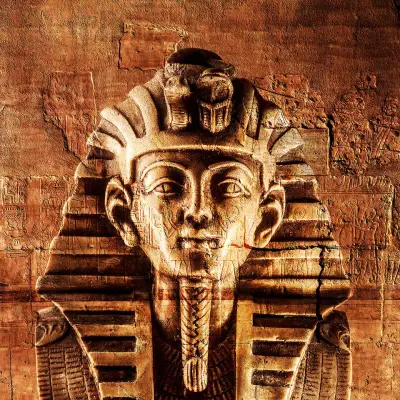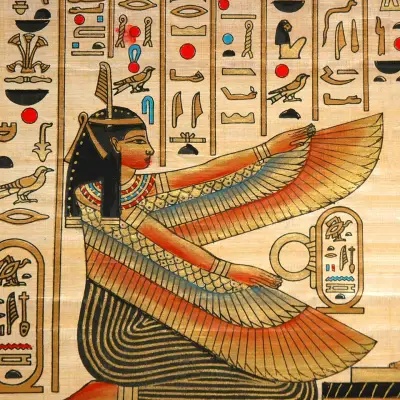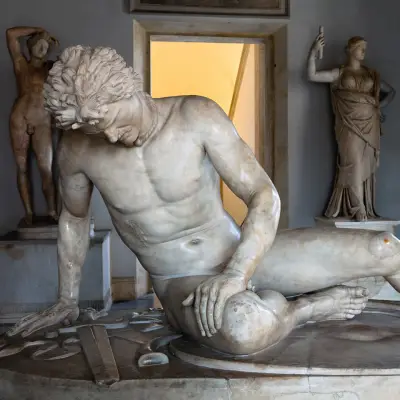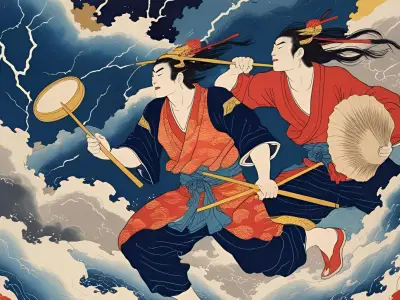Japanese mythology is a rich tapestry of gods, goddesses, and divine beings, each with its own unique stories, powers, and symbolic meanings. Whether you’re intrigued by tales of creation, curious about ancient deities, or exploring spiritual beliefs, understanding the roles of these mythological figures can provide valuable insights into Japan’s cultural heritage.
In Japanese mythology, the gods and goddesses are intricately woven into the natural world and everyday life. They embody the forces of nature, the mysteries of life and death, and the eternal dance between order and chaos. Let's explore some of the most prominent and influential Japanese gods and goddesses, each with their own compelling stories and enduring impact.
Jump to:
- Amaterasu: The Sun Goddess
- Susanoo: The Storm God
- Tsukuyomi: The Moon God
- Hachiman: The God of War
- Inari: The Deity of Prosperity
- Izanagi and Izanami: The Creator Deities
- Raijin: The God of Thunder
- Fujin: The God of Wind
- Ebisu: The God of Prosperity and Fishing
- Benzaiten: The Goddess of Music and Knowledge
- Tenjin: The God of Learning
- Jizo: The Guardian of Children and Travellers
- Frequently Asked Questions About Japanese Gods and Goddesses
- Study Our Japanese History and Culture Diploma for £29
Recommended for you!
Best Sellers1. Amaterasu: The Sun Goddess
Amaterasu Omikami is the powerful goddess of the sun and one of the central deities in Japanese mythology. She represents warmth, light, and the life-giving energy of the sun. As the main goddess in Shinto beliefs, she’s also considered the spiritual ancestor of the imperial family, symbolising order, purity, and divine power.
Amaterasu’s influence extends to earthly realms, where she is worshipped as the protector of Japan, embodying the light of truth and the essence of renewal. Her grand shrine at Ise, rebuilt every 20 years, signifies the cyclical nature of life and the importance of continuity.
Popular Myths
The most well-known myth involving Amaterasu is her retreat into a cave after a violent clash with her brother Susanoo. Enraged by his actions, she shuts herself away, plunging the world into darkness. The other gods, desperate to restore light, devise a plan involving music, dance, and a mirror to coax her out. When she emerges, her radiance fills the world once again, symbolising the triumph of light over darkness and the restoration of balance.
2. Susanoo: The Storm God
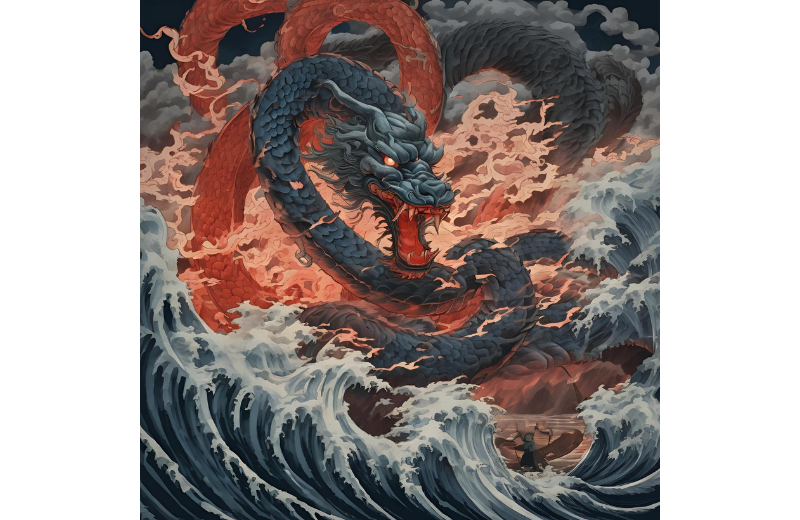
Susanoo-no-Mikoto is the god of storms and seas, representing the untamed forces of nature and the unpredictable power of the ocean. Unlike his sister Amaterasu, who is peaceful and controlled, Susanoo is wild and impulsive. Despite his chaotic nature, he’s also a protector, demonstrating his duality as both a destructive force and a heroic figure.
In Shinto belief, Susanoo is the embodiment of chaos and rebellion, yet he’s also celebrated for his bravery and cunning, particularly in moments of crisis.
Popular Myths
One of Susanoo’s most celebrated myths is his battle with the eight-headed serpent Yamata no Orochi. Banished from heaven for his reckless behaviour, Susanoo encounters a family that has lost seven daughters to the monstrous serpent and is about to lose the last. Susanoo devises a plan, preparing barrels of sake to intoxicate the beast. While the serpent is incapacitated, he slays it and discovers the legendary sword Kusanagi within its body. This sword later becomes a sacred treasure of the imperial family, symbolising divine authority and courage.
3. Tsukuyomi: The Moon God
Tsukuyomi-no-Mikoto, the god of the moon, is a deity of calmness, night, and reflection. Unlike his sister Amaterasu, who symbolises life and warmth, Tsukuyomi is a more aloof and solitary figure. His association with the moon highlights the contrast between light and dark, day and night.
Despite his serene exterior, Tsukuyomi is also a god of justice and retribution, demonstrating a stern sense of morality in the face of perceived wrongdoing.
Popular Myths
In a famous myth, Tsukuyomi is invited to a banquet hosted by Uke Mochi, the goddess of food. When he witnesses her unconventional method of producing food by spitting and excreting it, he is disgusted and kills her in a fit of rage. This act horrifies Amaterasu, who decides to distance herself from her brother forever. This separation of night and day reflects the eternal divide between light and darkness, a motif common in Japanese mythology.
4. Hachiman: The God of War

Hachiman is the god of war and warriors, symbolising strength, protection, and martial prowess. However, he’s also a deity of peace and harmony, embodying the principles of compassion and righteous action. As the divine protector of Japan, he is particularly worshipped by the samurai, who seek his blessings for courage and success in battle.
Hachiman’s dual nature as both a war god and a peaceful guardian highlights the balance between conflict and resolution, making him a symbol of both power and benevolence.
Popular Myths
Hachiman is believed to be the deified spirit of Emperor Ojin, a legendary figure whose martial skills and leadership earned him a divine status. Over time, Hachiman’s image evolved, incorporating elements of both Shinto and Buddhist traditions, resulting in a syncretic deity whose influence extends beyond the battlefield to the protection of civilians, children, and communities.
5. Inari: The Deity of Prosperity
Inari Okami is a multifaceted deity associated with agriculture, rice, fertility, and foxes. Inari’s presence is deeply rooted in Japan’s agricultural history, symbolising abundance, wealth, and prosperity. Foxes, or kitsune, serve as Inari’s messengers, and their mystical powers are often depicted in art and folklore.
Inari’s gender is fluid, appearing as a male warrior, a nurturing mother, or an androgynous figure, depending on the context and region. This fluidity reflects Inari’s adaptability and encompassing nature.
Popular Myths
Inari’s shrines, often marked by red torii gates and fox statues, are widespread throughout Japan. One popular myth involves Inari bestowing rice and prosperity upon a humble farmer in return for his kindness to a fox. This tale highlights Inari’s role as a benefactor of the poor and a protector of crops, linking the deity’s power to both material and spiritual wealth.
6. Izanagi and Izanami: The Creator Deities
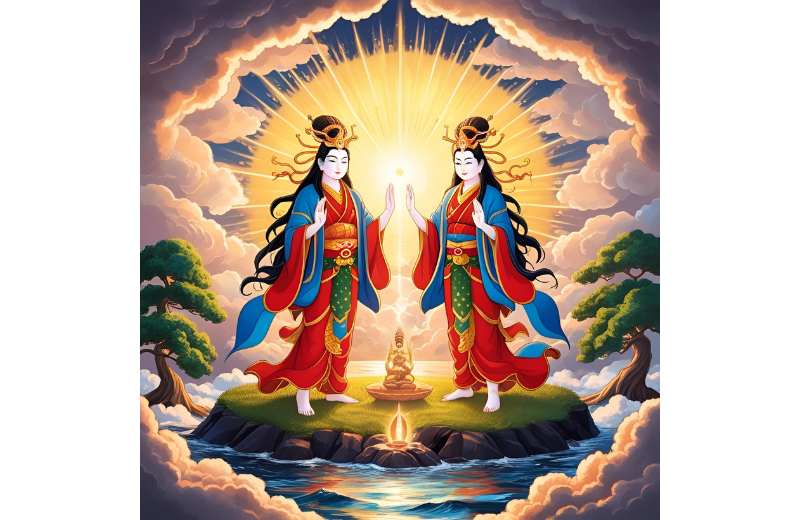
Izanagi and Izanami are the divine creators of the Japanese islands and the progenitors of numerous gods. They symbolise the duality of creation and destruction, life and death. Izanagi, the male deity, represents the sky and heaven, while Izanami, the female deity, embodies earth and the underworld.
Together, they illustrate the natural cycle of life, death, and rebirth, shaping the cosmos and governing the fate of all beings.
Popular Myths
According to myth, after giving birth to numerous islands and deities, Izanami dies while delivering Kagutsuchi, the god of fire. Devastated, Izanagi journeys to Yomi, the underworld, to bring her back, but upon seeing her decayed form, he flees in horror. In her rage, Izanami vows to take a thousand lives every day, while Izanagi responds that he will give life to fifteen hundred, symbolising the cycle of life and death.
7. Raijin: The God of Thunder
Raijin, the god of thunder and lightning, is a fearsome deity known for his powerful drumming, which is said to create thunder. Often depicted as a muscular, demonic figure surrounded by drums, he symbolises the raw and unpredictable power of nature. Raijin’s presence is both feared and respected, representing the destructive yet essential forces of storms and rainfall.
In Shinto beliefs, Raijin is not only a bringer of storms but also a protector against evil spirits. Farmers pray to Raijin for rainfall to ensure bountiful crops, demonstrating his dual nature as both a destructive force and a provider of life-giving water.
Popular Myths
According to legend, Raijin was originally born from Izanami after her death and descent to Yomi. As she lay in the underworld, her decaying body produced several fearsome gods, including Raijin. He’s often portrayed alongside his brother Fujin, the god of wind, as they roam the skies, creating storms and tempests. In one famous myth, Raijin’s drums are stolen by a cunning child named Momotaro, leading to a dramatic chase across the heavens.
8. Fujin: The God of Wind
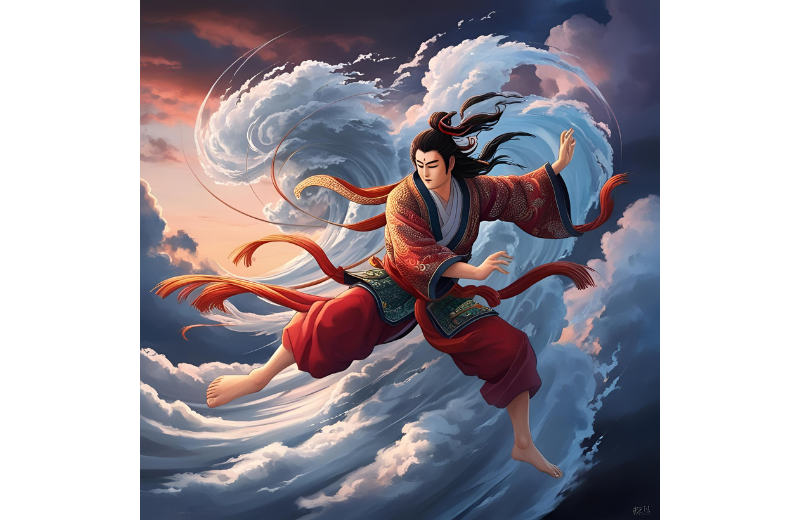
Fujin, the god of wind, is another powerful deity often depicted alongside his brother Raijin. He’s typically portrayed as a towering, demonic figure carrying a large bag of wind, which he uses to release gusts that sweep across the land. Fujin symbolises both the destructive and life-sustaining aspects of wind, embodying the balance between chaos and calm.
Fujin’s winds are believed to cleanse impurities and carry away evil spirits, making him a protector against malevolent forces. He is also credited with shaping the islands of Japan, using his powerful gusts to carve out the landscape.
Popular Myths
In one tale, Fujin is said to have helped the Japanese forces during the Mongol invasions of the 13th century. According to legend, Fujin and Raijin unleashed a powerful typhoon, known as the kamikaze or "divine wind," that destroyed the Mongol fleet, saving Japan from invasion. This event solidified Fujin’s reputation as a protector of the nation and a bringer of divine intervention.
9. Ebisu: The God of Prosperity and Fishing
Ebisu is the god of fishermen, luck, and prosperity, one of the Seven Lucky Gods in Japanese folklore. He’s portrayed as a cheerful, rotund figure holding a fishing rod and a large sea bream, symbols of abundance and good fortune. Ebisu is unique among the gods as he is the only deity who is not of divine origin but was once a human.
Despite his humble beginnings, Ebisu became a beloved figure representing perseverance, joy, and the rewards of hard work. He’s also a protector of children and a patron of merchants and artisans, emphasising his role as a bringer of wealth and success.
Popular Myths
According to legend, Ebisu was born as the deformed child of Izanagi and Izanami. Initially abandoned by his parents, he survived against all odds and grew into a benevolent god. His resilience and cheerful disposition made him a symbol of overcoming adversity and achieving prosperity. Today, Ebisu’s festival is celebrated with feasts and prayers for good fortune, and his statues can be found at fishing ports and marketplaces across Japan.
10. Benzaiten: The Goddess of Music and Knowledge
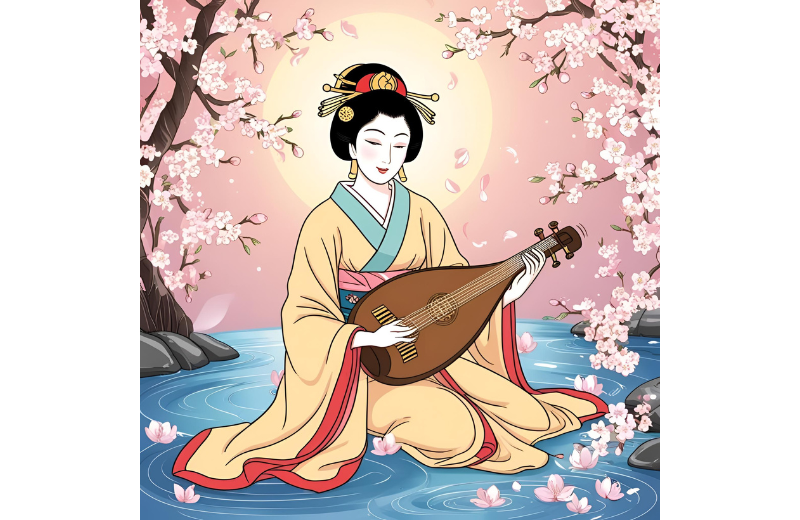
Benzaiten, also known as Benten, is the goddess of music, art, and wisdom, representing the transformative power of creativity and intellect. She’s depicted as a beautiful woman playing a biwa (Japanese lute) and is associated with water, reflecting her fluid and adaptable nature.
Originally of Hindu origin, Benzaiten was incorporated into Japanese mythology and became one of the Seven Lucky Gods, symbolising eloquence, inspiration, and artistic talent. Her association with water also connects her to serpents and dragons, creatures representing change and protection.
Popular Myths
In one popular myth, Benzaiten is said to have subdued a giant serpent that terrorised a village. Using her music and divine powers, she calmed the serpent and transformed it into a guardian spirit. This story highlights her role as a compassionate and wise goddess capable of taming chaos and bringing harmony. Today, she’s worshipped at numerous shrines, particularly those near bodies of water, and is revered as a protector of artists, musicians, and scholars.
11. Tenjin: The God of Learning
Tenjin, originally known as Sugawara no Michizane, is the god of scholarship, learning, and literature. He was a historical figure, a poet and scholar who was unjustly exiled and later deified as a god. Tenjin represents the pursuit of knowledge, the power of words, and the resilience of the human spirit.
Students and scholars pray to Tenjin for success in exams, and his shrines, known as Tenmangu, are adorned with votive tablets bearing wishes for academic achievement. He’s also associated with plum blossoms, symbolising perseverance and hope.
Popular Myths
After his death, Sugawara no Michizane was believed to have caused severe storms and disasters, leading people to fear his vengeful spirit. In order to appease him, he was posthumously deified as Tenjin, the god of learning and literature. Over time, he became a symbol of intellectual pursuit and academic excellence. Today, students across Japan visit Tenjin shrines to seek his blessing before important exams, making him one of the most widely worshipped deities in contemporary Japanese culture.
12. Jizo: The Guardian of Children and Travellers

Jizo Bosatsu is a compassionate deity known as the protector of children, travellers, and the souls of the deceased. Depicted as a monk with a serene expression, Jizo carries a staff with six rings and a wish-granting jewel, symbolising his commitment to guiding souls through the afterlife.
In Japanese Buddhism, Jizo is regarded as a bodhisattva who vowed to remain on earth until all souls are saved from suffering. His statues, often adorned with red bibs and hats, are placed along roadsides, graveyards, and temples to comfort the spirits of lost children and travellers.
Popular Myths
One poignant myth involving Jizo tells the story of a grieving mother who lost her child. Wandering the underworld, the child is found by Jizo, who protects the soul and offers guidance to the afterlife. This tale illustrates Jizo’s role as a compassionate guardian, easing the suffering of both the living and the dead. Parents who have lost children often make offerings to Jizo, seeking his protection and comfort.
Recommended for you!
Best SellersFrequently Asked Questions About Japanese Gods and Goddesses
Are the 7 Lucky Gods Shinto?
The Seven Lucky Gods are a blend of Shinto and Buddhist deities, representing good fortune and happiness. Each of these gods embodies different aspects of luck, from prosperity and longevity to love and wisdom, making them highly revered in Japanese folklore.
Who is the Japanese god of chaos?
Susanoo, the storm god, is often associated with chaos and unruly behaviour. Despite his unpredictable nature, he’s also celebrated for his bravery and heroic deeds, such as defeating the eight-headed serpent Yamata no Orochi.
Who is the Japanese goddess of death?
Izanami became the goddess of death after her descent into Yomi, the underworld. Her tragic transformation from a life-giving creator to a vengeful spirit serves as a cautionary tale about the consequences of breaking divine taboos.
Who is the god of swords in Japanese mythology?
The god of swords is often associated with Susanoo, who discovered the sacred sword Kusanagi within the serpent Yamata no Orochi. This sword became one of the three imperial regalia of Japan, symbolising power and divine protection.
Who is the Japanese god of love?
Aizen Myo-o is regarded as the god of love, desire, and passion, particularly in Buddhist traditions. He’s depicted as a fierce protector who transforms base desires into spiritual enlightenment, making him a unique figure in the pantheon.
Who is the most feared Japanese god?
Susanoo, the storm god, is considered one of the most feared due to his chaotic nature and unpredictable temperament. However, Emma-O, the ruler of the underworld, is also feared for his role in judging and punishing souls in the afterlife.
Who is the Japanese god of pain?
While there is no specific god solely associated with pain, Emma-O, the ruler of the underworld, oversees the suffering of souls in Yomi. He determines the fate of the deceased, inflicting punishment upon those who led wicked lives.
Who is the most beautiful goddess in Japan?
Benzaiten, the goddess of music, art, and wisdom, is often portrayed as the most beautiful goddess in Japanese mythology. Her grace and elegance are said to inspire creativity and harmony, making her a beloved figure among artists and musicians.
Who is the Japanese god of chaos and destruction?
Susanoo, with his tempestuous nature, is the primary god associated with chaos and destruction. His ability to unleash storms and cause havoc mirrors the unpredictable power of the sea and sky.
Who is the protector of children in Japanese mythology?
Jizo Bosatsu is regarded as the protector of children, travellers, and the souls of the deceased. He is depicted as a gentle monk who offers guidance and protection, particularly to lost and suffering souls.
Who is the Japanese god of fertility and prosperity?
Inari Okami is the god of fertility, rice, and prosperity. Often depicted with foxes as messengers, Inari is revered by farmers, merchants, and artisans for bringing abundance and good fortune.
Are Japanese gods still worshipped today?
Many Japanese gods and goddesses are still worshipped today, especially in Shinto shrines and during seasonal festivals. Their stories and attributes continue to resonate, linking modern practices to ancient traditions.
Study Our Japanese History and Culture Diploma for £29
If you want to learn more about the myths, legends, and cultural significance of these deities, why not take your online learning further with a diploma? Our Introduction to Japanese History and Culture Diploma Course allows you to explore Japanese mythology, spiritual beliefs, and historical traditions at your own pace. For a limited time, enrol for just £29!

